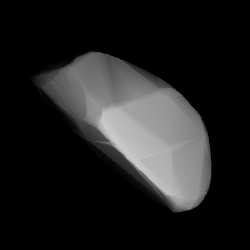
Summary
2064 Thomsen (prov. designation: 1942 RQ) is a stony asteroid and Mars-crosser on an eccentric orbit, that measures approximately 13 kilometers (8.1 miles) in diameter. The asteroid was discovered by Finnish astronomer Liisi Oterma at Turku Observatory, Finland, on 8 September 1942.[3] It was named after New Zealand astronomer Ivan Leslie Thomsen
 Shape model of Thomsen from its lightcurve | |
| Discovery [1] | |
|---|---|
| Discovered by | L. Oterma |
| Discovery site | Turku Obs. |
| Discovery date | 8 September 1942 |
| Designations | |
| (2064) Thomsen | |
Named after | Ivan Leslie Thomsen (New Zealand astronomer)[2] |
| 1942 RQ · 1958 RO 1974 OK · 1977 FE3 1977 KA · A913 QB | |
| Mars-crosser [1][3] | |
| Orbital characteristics [1] | |
| Epoch 4 September 2017 (JD 2458000.5) | |
| Uncertainty parameter 0 | |
| Observation arc | 74.50 yr (27,211 days) |
| Aphelion | 2.8967 AU |
| Perihelion | 1.4600 AU |
| 2.1783 AU | |
| Eccentricity | 0.3298 |
| 3.22 yr (1,174 days) | |
| 142.30° | |
| 0° 18m 23.76s / day | |
| Inclination | 5.6946° |
| 302.16° | |
| 2.7479° | |
| Earth MOID | 0.4446 AU |
| Physical characteristics | |
Mean diameter | 8.09±0.12 km[4] 13.59 km (derived)[5] 13.61±1.6 km (IRAS:2)[6] |
| 4.2267±0.0001 h[7] 4.233 h[8] 4.244023±0.000001 h[9] 4.253±0.005 h[10] | |
| 0.0549±0.015 (IRAS:2)[6] 0.0644 (derived)[5] 0.162±0.006[4] | |
| SMASS = S[1] · S [5][11][12] B–V = 0.887[1] U–B = 0.524[1] | |
| 12.6[1] · 12.93[5][8] · 13.10[4][6][12] · 13.44±0.31[11] | |
Orbit and classification edit
The S-type asteroid orbits the Sun in the inner main-belt at a distance of 1.5–2.9 AU once every 3 years and 3 months (1,174 days). Its orbit has an eccentricity of 0.33 and an inclination of 6° with respect to the ecliptic.[1]
Naming edit
This minor planet was named in memory of New Zealand astronomer Ivan Leslie Thomsen (1910–1969), director of the Carter Observatory, Wellington, from 1945 until he was appointed director of the Mount John University Observatory only two months before his death. He was an enthusiastic coordinator of New Zealand's astronomy and his efforts eventually led to the minor-planet observing program with the Carter Observatory 41-cm reflector. It was the 1977 rediscovery at the Carter Observatory that allowed this minor planet to be numbered. The official naming citation was published by the Minor Planet Center on 1 August 1978 (M.P.C. 4421).[2][13]
Physical characteristics edit
Four rotational lightcurves gave a well-defined rotation period of 4.233 hours with a brightness variation of 0.62–0.69 magnitude (U=3/3/ .a./3)[7][8][9][10] and an albedo of 0.055 and 0.16, as measured by the IRAS and Akari surveys, respectively.[4][6]
References edit
- ^ a b c d e f g h "JPL Small-Body Database Browser: 2064 Thomsen (1942 RQ)" (2017-03-09 last obs.). Jet Propulsion Laboratory. Archived from the original on 20 December 2016. Retrieved 11 June 2017.
- ^ a b Schmadel, Lutz D. (2007). "(2064) Thomsen". Dictionary of Minor Planet Names. Springer Berlin Heidelberg. p. 167. doi:10.1007/978-3-540-29925-7_2065. ISBN 978-3-540-00238-3.
- ^ a b "2064 Thomsen (1942 RQ)". Minor Planet Center. Retrieved 8 December 2016.
- ^ a b c d Usui, Fumihiko; Kuroda, Daisuke; Müller, Thomas G.; Hasegawa, Sunao; Ishiguro, Masateru; Ootsubo, Takafumi; et al. (October 2011). "Asteroid Catalog Using Akari: AKARI/IRC Mid-Infrared Asteroid Survey". Publications of the Astronomical Society of Japan. 63 (5): 1117–1138. Bibcode:2011PASJ...63.1117U. doi:10.1093/pasj/63.5.1117. (online, AcuA catalog p. 153)
- ^ a b c d "LCDB Data for (2064) Thomsen". Asteroid Lightcurve Database (LCDB). Retrieved 8 December 2016.
- ^ a b c d Tedesco, E. F.; Noah, P. V.; Noah, M.; Price, S. D. (October 2004). "IRAS Minor Planet Survey V6.0". NASA Planetary Data System. 12: IRAS-A-FPA-3-RDR-IMPS-V6.0. Bibcode:2004PDSS...12.....T. Retrieved 22 October 2019.
- ^ a b Behrend, Raoul. "Asteroids and comets rotation curves – (2064) Thomsen". Geneva Observatory. Retrieved 8 December 2016.
- ^ a b c Wisniewski, W. Z. (March 1991). "Physical studies of small asteroids. I - Lightcurves and taxonomy of 10 asteroids". Icarus. 90 (1): 117–122. Bibcode:1991Icar...90..117W. doi:10.1016/0019-1035(91)90073-3. ISSN 0019-1035. Retrieved 8 December 2016.
- ^ a b Durech, J.; Hanus, J.; Oszkiewicz, D.; Vanco, R. (March 2016). "Asteroid models from the Lowell photometric database". Astronomy and Astrophysics. 587: 6. arXiv:1601.02909. Bibcode:2016A&A...587A..48D. doi:10.1051/0004-6361/201527573. Retrieved 8 December 2016.
- ^ a b Warner, Brian D. (July 2015). "Asteroid Lightcurve Analysis at CS3-Palmer Divide Station: 2014 December - 2015 March" (PDF). Minor Planet Bulletin. 42 (3): 167–172. Bibcode:2015MPBu...42..167W. ISSN 1052-8091. Archived from the original (PDF) on 18 February 2020. Retrieved 18 March 2020.
- ^ a b Veres, Peter; Jedicke, Robert; Fitzsimmons, Alan; Denneau, Larry; Granvik, Mikael; Bolin, Bryce; et al. (November 2015). "Absolute magnitudes and slope parameters for 250,000 asteroids observed by Pan-STARRS PS1 - Preliminary results". Icarus. 261: 34–47. arXiv:1506.00762. Bibcode:2015Icar..261...34V. doi:10.1016/j.icarus.2015.08.007. Retrieved 8 December 2016.
- ^ a b Carry, B.; Solano, E.; Eggl, S.; DeMeo, F. E. (April 2016). "Spectral properties of near-Earth and Mars-crossing asteroids using Sloan photometry". Icarus. 268: 340–354. arXiv:1601.02087. Bibcode:2016Icar..268..340C. doi:10.1016/j.icarus.2015.12.047.
- ^ Schmadel, Lutz D. (2009). "Appendix – Publication Dates of the MPCs". Dictionary of Minor Planet Names – Addendum to Fifth Edition (2006–2008). Springer Berlin Heidelberg. p. 221. doi:10.1007/978-3-642-01965-4. ISBN 978-3-642-01964-7.
External links edit
- Lightcurve Database Query (LCDB), at www.minorplanet.info
- Dictionary of Minor Planet Names, Google books
- Asteroids and comets rotation curves, CdR – Geneva Observatory, Raoul Behrend
- 2064 Thomsen at AstDyS-2, Asteroids—Dynamic Site
- Ephemeris · Observation prediction · Orbital info · Proper elements · Observational info
- 2064 Thomsen at the JPL Small-Body Database


